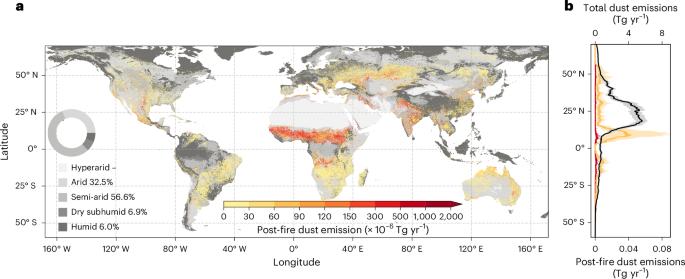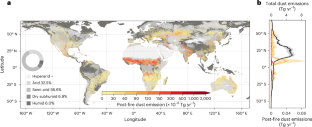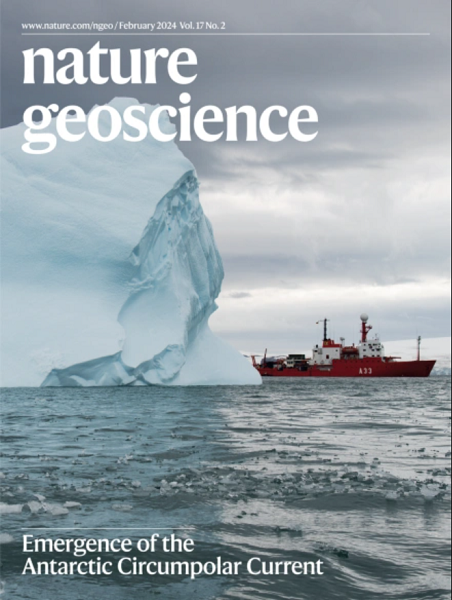主要由小型火灾引起的燃烧景观的粉尘排放增加
IF 16.1
1区 地球科学
Q1 GEOSCIENCES, MULTIDISCIPLINARY
引用次数: 0
摘要
野火减少了植被覆盖和土壤生物结皮,从而扩大了易受风蚀的裸地。然而,火灾后粉尘排放的全球特征仍然是定性的,并且只关注受相对较大的野火干扰的景观。在这里,我们将流体力学原理应用于卫星测量,以量化火灾后的粉尘排放。研究发现,全球61%的不同程度的野火都伴随着粉尘排放的增加,2003 - 2022年期间每年注入5.6 (3.3-9.2)Tg的粉尘。95%的火灾后粉尘排放来自小型野火,它们比大型野火发生的频率和范围更广,特别是在植被稀少的地区。尽管近年来全球燃烧面积减少,因此火灾后粉尘事件的发生减少,但全球火灾后粉尘排放总量在过去20年中增加了77%。火灾后粉尘排放总量的增加是由于燃烧加剧和火灾引起的土地退化加剧,这导致火灾后粉尘排放强度增加了155%。随着全球变暖背景下极端野火和同步干旱的持续增加,我们的研究结果表明,全球和区域火灾后粉尘排放的重要性日益凸显。本文章由计算机程序翻译,如有差异,请以英文原文为准。


Rise in dust emissions from burned landscapes primarily driven by small fires
Wildfires reduce vegetation cover and soil biocrust, thus expanding bare grounds susceptible to wind erosion. However, global characterization of post-fire dust emissions has remained qualitative and focused only on landscapes disturbed by relatively large wildfires. Here we apply principles of fluid mechanics to satellite measurements to quantify post-fire dust emissions. We find that 61% of global wildfires at various extents are followed by enhanced dust emissions, injecting 5.6 (3.3–9.2) Tg of dust per year during 2003 to 2022. 95% of the post-fire dust emissions are sourced to small wildfires, which occur more frequently and broadly than large wildfires especially across sparsely vegetated regions. Despite the recent decline in global burned area and a resultant decreasing occurrence of post-fire dust events, the total amount of global post-fire dust emissions has increased by 77% during the last two decades. This elevation in total post-fire dust emissions is attributed to intensifying burning and worsening fire-induced land degradation, which trigger a 155% increase in the intensity of post-fire dust emissions. With an ongoing enhancement of extreme wildfires and synchronized droughts under global warming, our results indicate the emerging importance of post-fire dust emissions globally and regionally. Post-fire dust emissions have increased by 77% globally over the past two decades, and small fires account for 95% of these emissions, according to analysis of satellite observations.
求助全文
通过发布文献求助,成功后即可免费获取论文全文。
去求助
来源期刊

Nature Geoscience
地学-地球科学综合
CiteScore
26.70
自引率
1.60%
发文量
187
审稿时长
3.3 months
期刊介绍:
Nature Geoscience is a monthly interdisciplinary journal that gathers top-tier research spanning Earth Sciences and related fields.
The journal covers all geoscience disciplines, including fieldwork, modeling, and theoretical studies.
Topics include atmospheric science, biogeochemistry, climate science, geobiology, geochemistry, geoinformatics, remote sensing, geology, geomagnetism, paleomagnetism, geomorphology, geophysics, glaciology, hydrology, limnology, mineralogy, oceanography, paleontology, paleoclimatology, paleoceanography, petrology, planetary science, seismology, space physics, tectonics, and volcanology.
Nature Geoscience upholds its commitment to publishing significant, high-quality Earth Sciences research through fair, rapid, and rigorous peer review, overseen by a team of full-time professional editors.
 求助内容:
求助内容: 应助结果提醒方式:
应助结果提醒方式:


